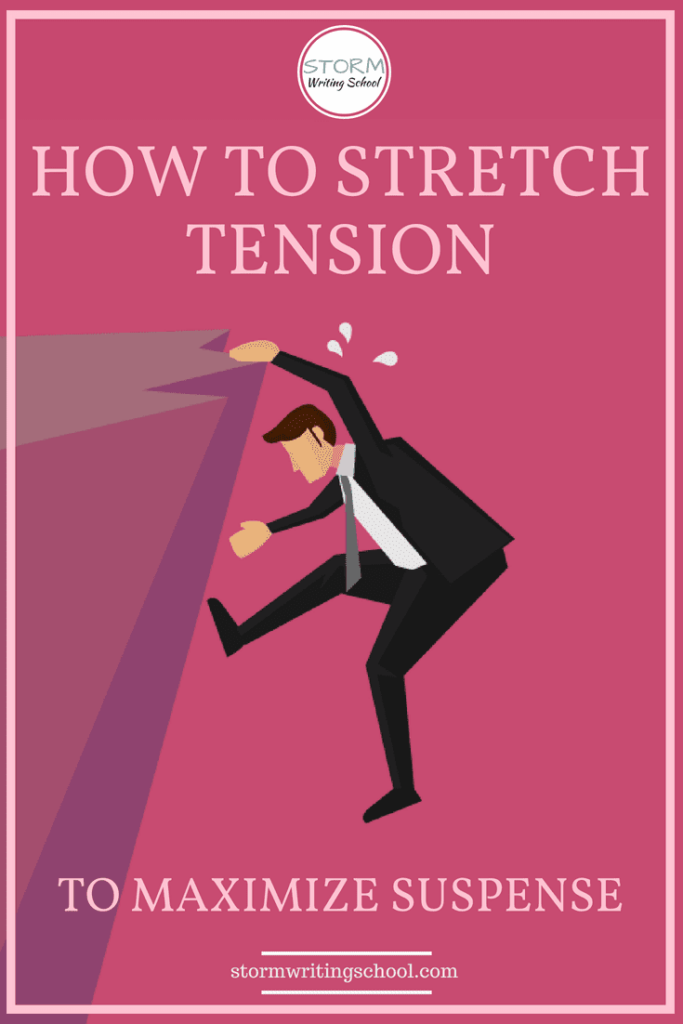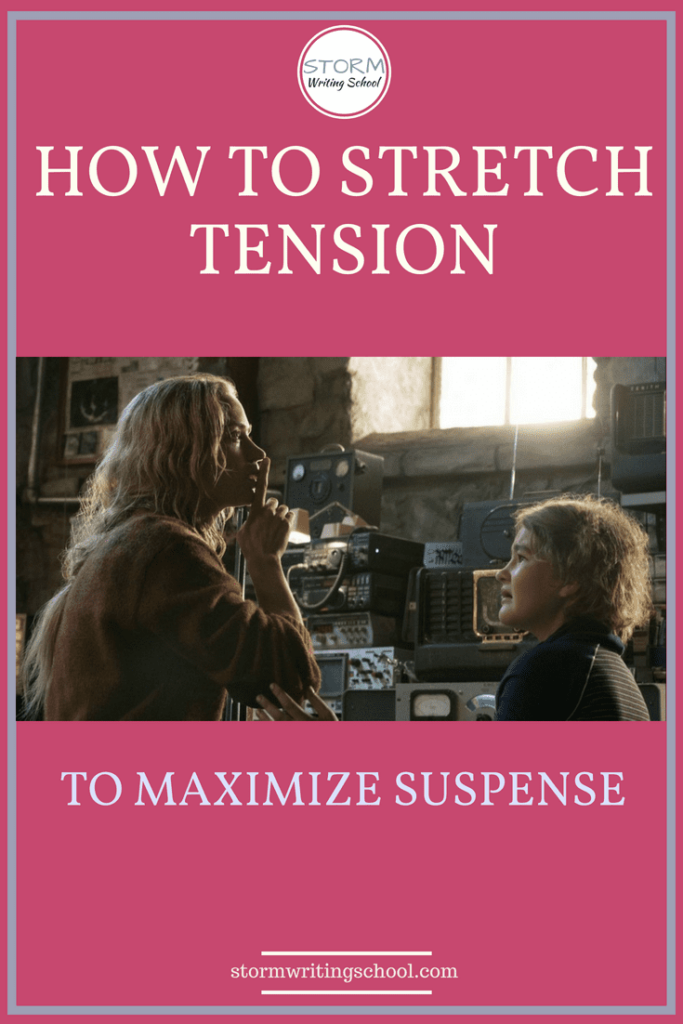Don’t push the action off-stage or rush through it. Linger on the most tense moments of the story to maximize engagement.


The Unstretched Scene
Here’s a scenario I see often in my editing work: the writer gets a POV character into trouble and then speeds right through it and gives us a resolution in a paragraph rather than pages.
It looks like this scene, involving two characters in an abandoned zoo:
Sanjiv tried the door. It was unlocked. “Hey!” he yelled to Tara. “This door works.”
No reply.
He shrugged and entered the enclosure. Light flooded the space through high-ceilinged skylights. He squinted at the habitat, giving his eyes a moment to adjust. At the center of the room stood a sort of tower that rose nearly 30 feet, with platforms every 10 feet or so. From it spanned monkey bars, beams, and ropes, running to two smaller adjacent towers. It was clearly a primate habitat.
As he scanned the room, the stench caught up to him; there was something more here than just the animal musk that had confronted them at every turn. It was rot. Decay. He looked around, his eyes now accostomed to the brightness. It was hot in here. Steamy.
And there, below a tire swing, he spotted the carcass. It was a dead chimp, its face and arms chewed to a pulp. His body revolted. He gagged and dry-heaved. He covered his mouth and nose and ran back to the door.
It was locked.
Of course it’s locked, he thought. He scolded himself for not propping it open.
Then he scanned the room for another door, knowing he’d find none. The enclosure had a triangular floor plan, with one of the three walls made of thick glass. That’s where the zoo patrons would have watched the animals. In the far corner of the room, he saw a curious pile of sticks, forming what looked to be a makeshift lean-to. And inside was . . . a chimp. A living chimp, its eyes half shut but fixated on Sanjiv.
Sanjiv quelled the urge to shriek. He looked away immediately, remembering that some primates take offense at eye contact. Were chimps one of them?
He pretended not to have noticed; he kept scanning the room, keeping the chimp in his peripheral vision and wondering if there was anything in here he could use as a weapon.
Just then, the door clicked open. “There you are!” said Tara. Sanjiv dove for the opening and threw his body into the darkness, shouting “Close it! Close the door!”
What Is Stretching Tension?
Now, the above isn’t even close to the worst scene I’ve seen—I mean, at least this one has some nice buildup to the threat—but I like to use relatively competent writing as examples of what not to do because it’s more edifying than critiquing a straw man of a passage.
In this particular scene, just as Sanjiv is encountering a true threat, he’s rescued by Tara (read more about that problem here). What would happen if we lingered within the trouble more? That’s a question I often ask writers. When you stretch the tension, you usually get the reader even more invested in the story.
Do you have any passages like this? Do you take us to a point of conflict and then, rather than allow us to see it play out and get all worried about the outcome, you summarize it or just resolve it quickly?
Stretching tension means you lengthen the scene but also make it more gripping.
In my course on Story Momentum, I differentiate stretching tension from bridging conflict, the other method of getting tension on the page. Bridging conflict is about adding more conflicts; stretching tension is about eking as much tension as possible out of one objective, one conflict.
- A man has to get through the airport and board a plane without getting flagged as suspicious.
- Federal agents escorting a person of interest have spotted a vehicle of armed assailants and have to neutralize them.
- A woman has gone to a funeral home to make arrangements for her mother’s burial and is about to see her mother’s dead body for the first time.
Within that one-objective, one-conflict situation, how can you create maximum suspense? That’s the concern for those wanting to stretch tension. And here’s a quick step-by-step guide.
The Guide
1. Establish the conflict.
You want to make it clear what kind of threat or obstacle the character is facing. That much, the sample passage above is getting right. Even if you keep the nature of the conflict a bit obscure, we should sense something is wrong right away.
In Naomi Alderman’s The Power, there’s a scene in which one of the POV characters, Margot Cleary, is sitting down for a test to determine whether she has the electrostatic power that girls and women throughout the world have suddenly gained. If the machine testing her reveals that she does have it, she could be out of a job. We’re introduced to that machine immediately.
In Benjamin Percy’s novel Red Moon, there’s an early scene in which a man arrives at an airport and makes his way to the gate, where he boards the plane. There’s a lot of mystery surrounding this scene, but we know he wants to make it onto the plane, we know he’s really nervous, and we know he’s a suspicious character. So even though the conflict is slightly obscure (that is, we might not be able to name it specifically), it’s oozing from the page the entire time.
So maybe the advice is better phrased not as making it clear what the threat is, but making it clear that there’s threat.
2. Have the character worry.
This has already been alluded to above, but get the character worrying about failure pretty early on. That worry introduces us to the heart of stretching tension: that failure and success have equal chance of happening. In fact, if you want to, you can give the impression that failure is more likely than success. You just can’t have success be more likely than failure.
If the conflict doesn’t provide real threat, there will be no tension. So be sure to make failure a real possibility that the character frets about.
In Percy’s Red Moon, the man in the airport sweats profusely and looks constantly for security guards.
In Alderman’s The Power, Margot anticipates that the test will reveal that she does indeed have the power, and that she’ll lose her job as a result.
3. (Optionally) Identify the stakes.
In some cases, the stakes are self-evident or you may want to keep them a mystery. But when a POV character is conscious of the stakes, the worry is magnified. More importantly, when the reader is conscious of stakes, the worry is magnified. Is there anything you can do to reveal less obvious stakes? Are there emotional stakes for your character? We may know what the stakes (failure to achieve the goal) are, but do we know that they mean to the character?
In the Red Moon scene, the stakes are pretty hidden from us, but in The Power, Margot will not only lose her job as mayor, she’ll be facing the end of her entire political career, and she’ll lose face among her peers and, most importanly, with her nemesis, the governor.
4. Cut off easy exits.
Simple one here. Let us know there’s no way out, that the character has to face this conflict in order to achieve their desires.
In Red Moon, the man desperately wants to get aboard the plane. He’s tempted to lose his forced composure several times, but he doesn’t because the only way on that plane is through fitting in and not drawing attention to himself.
In The Power, Margot cannot refuse the test if she wants to keep her job.
5. Create incremental successes and failures.
Remember, with stretching tension, you’re not creating new conflicts. The goal and threat remain the same throughout the scene. But you still want to alternate optimism and pessimism. Give us a little hope and then give us a bleak outlook. Again, this is the heart of stretching tension. Tease success; tease failure.
Percy’s POV character in the Red Moon scene sees some extra security detail: “They are waiting for him, he feels certain. And soon, any second now, they will rush forward and throw him to the floor and cuff his wrists.” Pessimism. “He is only a few feet away when they pull out of line a woman in a floppy hat and floral-patterned muumuu, apologizing to her, saying they’re randomly screening passengers. ‘For your safety,’ they say.” Optimism.
And look at this back-and-forth in The Power:
Margot feels that it would be pleasant, now, to discharge herself. It is like the feeling, on waking, that one might like to open one’s eyes. She resists. It is not difficult.
She breathes in, she breathes out. The woman operating the machines smiles, makes a note on her Xeroxed sheet of boxes. A fourth o in the fourth box. Nearly half way there. Of course, at some point, it will become impossible, Margot has read it in the literature.
6. (Optionally) Include a digression to the past.
Not necessary in all circumstances, but incorporating the past can often inform the success or failure of the present scene.
In The Power, Margot thinks of how she reacted when her husband told her he’d had an affair. It’s a small flashback that has parallels to the current scene, as it’s all about whether she can withstand shock (literal and figurative) and whether she can restrain herself.
Okay, then. Happy tension stretching! This is one of the many techniques for gaining story momentum that I discuss in my Story Momentum Mastery course. And boy, do I have a lot to say about tension. Check out these other resources:
- Escalating Complications
- Three Techniques for Creating Tension
- Antagonists
- The Tension Lab
- Creating Sexual Tension
Want to see a sample of a scene that stretches tension well? It’s within my free e-book, Tension in Action. Subscribe to get your hands on it.SaveSaveSaveSaveSaveSaveSaveSaveSaveSaveSaveSaveSaveSaveSaveSaveSaveSaveSaveSave





2 Responses